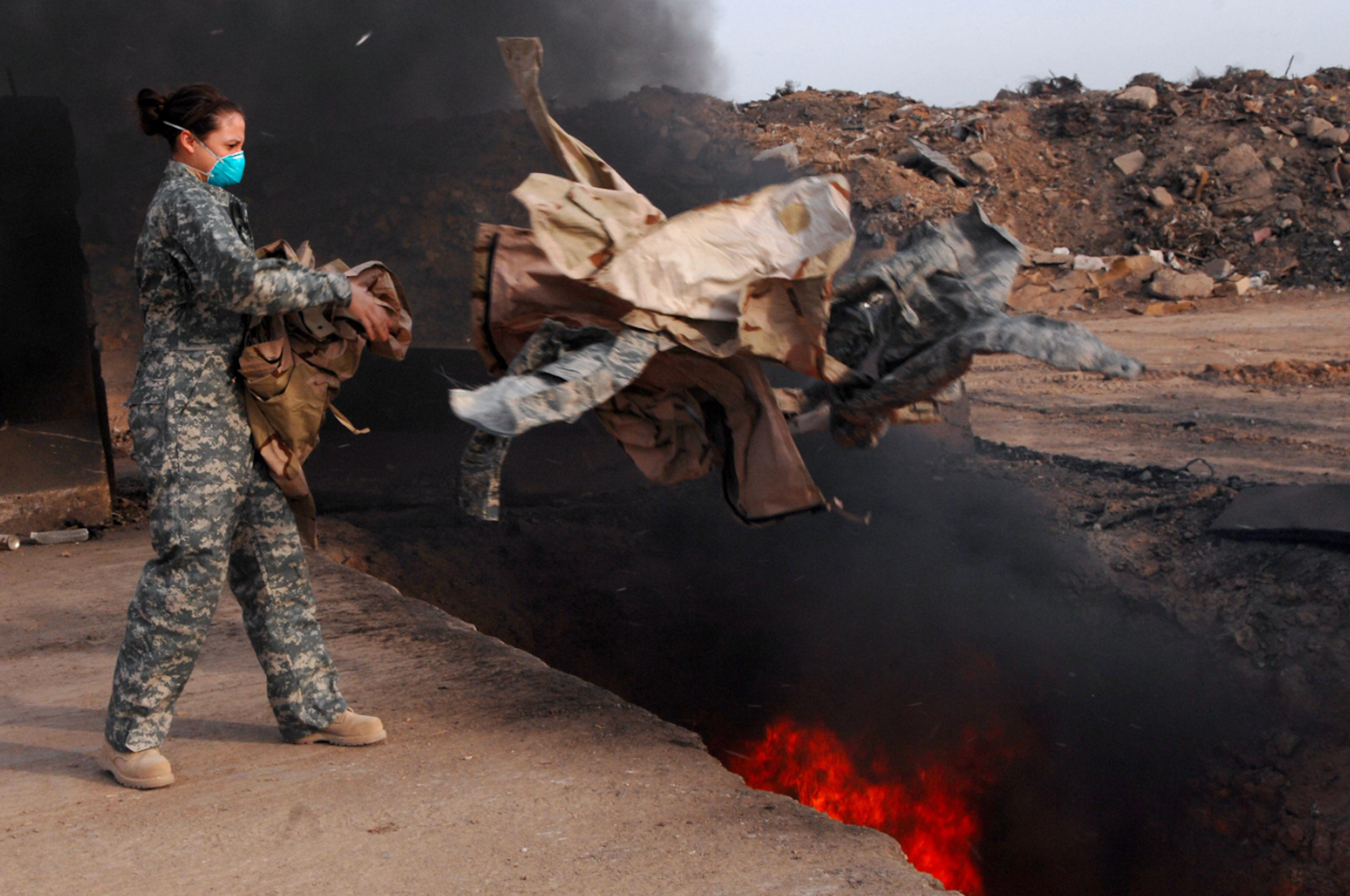
Hundreds of claims have been granted in Wyoming for those exposed to toxic substances in the line of duty.
By Madelyn Beck, WyoFile.com
Michael Elbrecht understands how discouraged many veterans became after the U.S. Department of Veterans Affairs denied them benefits for chronic and deadly illnesses. He’s been denied benefits, too — for the asthma he attributes to his work overseas, including his time at Joint Base Balad in Iraq near a massive 10-acre burn pit.
“I was at the base during the time when they were testing the air quality because of the open burn pits,” Elbrecht said. “It was in 2007, and the Air Force found out that the [level of toxicity] was just through the roof.”
The pit was full of just about anything you can think of, he said, including food, dead animals and garbage. Thick black smoke billowed from the top of it, creating an awful stench and constantly mingling with the air he breathed.
“It just burned 24 hours a day, seven days a week, nonstop,” he said.
When he finished his service, Elbrecht registered with the VA and started filing claims.
“And I don’t get approved for anything,” he said. “They say my asthma, it’s not due to my service.”
He entered a burn pit registry in 2014, but nothing immediately came of that, either.
Since the federal PACT Act went live in January, however, veterans should give the VA another chance to provide benefits that they deserve, Elbrecht said. He’s now the enrollment eligibility coordinator and environmental health coordinator at the Sheridan VA Medical Center, and he was a Wyoming test case for the PACT Act.
“I was able to file, and I got an approved claim through the [Veterans Benefits Administration] within less than two months,” he said.
To talk about a potential PACT Act claim, Elbrecht encourages beneficiaries to contact county veterans service officers, local VAs or Wyoming Veterans Commission. He also warns veterans to stay away from predatory companies which may take a sizeable chunk of someone’s disability benefits in exchange for filing claims for them.
There is one last piece of advice from Elbrecht for anyone making a claim to the VA: make sure to clearly state that an ailment is due to military service, what happened to cause that ailment and what the current diagnosis is.
“Those three steps are very critical to getting your claims approved,” he said.
The PACT Act
U.S. veterans have long suspected that exposures to toxic substances in the line of duty gave them cancers and respiratory illnesses, but it was nearly impossible to prove that to the VA to access benefits. That is, until the Sergeant First Class Heath Robinson Honoring our Promise to Address Comprehensive Toxics Act was signed into law last August.
The PACT Act now allows veterans with certain diseases who faced toxic exposures to get benefits — whether or not they can prove an illness’s origin. Those “presumptive” diseases include more than 20 categories ranging from emphysema to brain cancer.
Covered veterans who have those diseases only need to show that they’d worked in certain countries during certain time periods dating back to August 1990. Researchers found these veterans faced conditions that, in the aggregate, increased the risk for such illnesses, even if the cause of an ailment was hard to prove individually.
Beyond toxic exposure benefits for veterans, the PACT Act also increases access to benefits for their families, extends the timeframe veterans have to enroll in VA healthcare, calls for toxic exposure screenings, requires more health research and includes more “presumptive” illnesses covered for Vietnam era veterans.
An important upcoming deadline for the PACT Act is Aug. 10. If veterans submit claims before then, accepted claims will be backdated to August 2022. That means they’ll get additional payments.
There’s also an open enrollment deadline on Oct. 1 to access VA health care for some of those veterans who haven’t or couldn’t access it in the past.
Nationally, more than 275,000 PACT Act claims have been processed since January with about 84% granted.
In Wyoming, 798 claims had been processed as of June 7, and there was a 81.5% percent grant rate, according to Charles Cates, division chief for the benefits side of the VA in Cheyenne. That means 650 residents have received benefits so far, he said, and another 1,000 claims are in the queue.
Elbrecht said his first claim about a decade ago took over a year to process, so the two-month turnaround on his claim in Wyoming has been a significant improvement. It also beats the national average time spent processing a PACT Act claim, which is closer to five months.
Claim processing speed was a concern for some lawmakers, including Sen. Cynthia Lummis (R-Wyoming), who voted against the PACT Act.
“Right now, there are 168,000 vets waiting for VA services. That is unacceptable. If we pass the PACT Act, as is, that number jumps to over a million,” she said in a tweet last summer.
She was advocating to amend the PACT Act to allow veterans to seek care at non-VA facilities, but that amendment failed.
Lummis’ staff told Cowboy State Daily that she was also concerned by common diseases like high blood pressure being included in the law — hypertension was added as a presumptive illness for Vietnam era veterans exposed to agent orange — and the law’s initial price tag: about $280 billion over a decade.
Sen. John Barasso (R-Wyoming) voted alongside then-Rep. Liz Cheney in favor of the final version of the PACT Act.
While there are more claims being submitted, they’re being processed more efficiently than ever before, VA Under Secretary of Benefits Joshua Jacobs told a Congressional subcommittee last month.
“In Fiscal Year 2022, we set a record for the highest number of claims decisions in VBA history, and that was 1.7 million claims decided,” he said. “We’re about halfway through this fiscal year and we’re already well above where we were last year.”
The VA’s records include processing more than 9,000 claims in a single day this April. Beyond that, more non-PACT Act claims have been completed (about 1.2 million) than submitted (1.1 million) since last August, bringing wait times down to little over four months — not ideal, but an improvement.
The faster turnaround is partially thanks to a massive hiring effort.
“Even before President Biden signed the PACT Act into law, VA began actively hiring new employees to prepare for the expansion of benefits,” Jacobs said. “In fact, we’ve increased the VBA workforce by 15% over the last year and a half, and it now stands at more than 28,000.”
Those new staff were a necessity in the wake of this historic increase in veterans’ benefits: the PACT Act makes up 40% of VBA’s workload now, Jacobs said.
In Wyoming, Elbrecht says it’s taking up closer to 50% of his time right now if not more.
Rating specialists — which determine veterans’ level of disability benefits and eligibility — are also working a mandatory 20 hours of overtime each month, according to Cates in Cheyenne.
VA officials know mandatory overtime isn’t sustainable and are aiming to end it at some point in the future, Under Secretary Jacobs told lawmakers, but it’s hard to estimate when they can do so.
“We need to move away [from overtime], but we also have to be able to make sure that veterans aren’t waiting lengthy periods of time,” he said.
There will be several weeks where that mandated overtime is suspended this summer, Jacobs said. There are also efforts to attract and train new employees to process claims as well as incorporate more automation and technology to improve efficiencies.
Reaching the hard-to-reach
A big portion of the PACT Act involves getting the word out about these benefits before it’s too late, especially for those with terminal cancers.
That includes phone calls, emails and outreach events.
The Cheyenne VA office has held six outreach events so far, and the Sheridan VA office has held another three. There is also an upcoming town hall at Cheyenne’s VA on June 14 and planned outreach at the VA car show in Sheridan on July 1.
Between both offices, more than 16,500 Wyoming veterans have also been screened for toxic exposures.
Early efforts to get the word out appear to be paying off. According to the May 26 PACT Act Performance Dashboard, Wyoming represents 0.25% of the nation’s claims. The state is only home to 0.24% of U.S. veterans.
However, there is more work to do. Groups who haven’t had regular contact with the VA or have had bad prior experiences can be more difficult to reach. That includes older, pre-9/11 women veterans who were barred from participating in certain aspects of the military, according to Congressional testimony by retired U.S. Air Force Col. Lorry M. Fenner.
“It’s also hard to feel respected as a woman when you walk into the VA and you’re assumed to be somebody’s wife, mother or daughter — which we probably are — but not to be assumed to be the veterans ourselves,” said Fenner, a representative for the Service Women’s Action Network.
Kristina Miller in Wyoming echoes that sentiment. Miller is a veteran who also works in public affairs for the Sheridan VA health care system.
“As far as the women veterans, unfortunately, there’s still this belief that the VA is for just men,” she said. “And as a culture, we don’t see women veterans highlighted as much.”
Still, she said all VA offices are trying to make sure that women veterans know there are resources available for them.
Beyond the PACT Act, the Dr. Kate Hendricks Thomas Supporting Expanded Review for Veterans In Combat Environments Act aims to expand access to mammograms. That pairs with PACT Act provisions that list breast cancer as a presumptive illness under the “reproductive cancer” umbrella.
Concerns
Groups like Service Women’s Action Network, Wounded Warrior Project and AMVETS praised the PACT Act rollout, but had suggestions for Congress, too. That included better outreach to specific groups, like those who left the military with anything other than an honorable discharge.
“It’s not too long ago that women were put out of the service for lack of suitability for being pregnant or getting married and adopting their husband’s children,” Col. Fenner told a Congressional subcommittee. “Women have been put out of the service for [military sexual trauma] that’s affected their mental health and … the documents’ discharge says they’re unsuitable or ill-adapted. And then there’s LGBTQ members who were put out under ‘don’t ask don’t tell’ and/or got other than honorable discharges.”
Representatives of both the Wounded Warrior Project and American Veterans testified that they also want more data from the VA, including which types of claims aren’t being accepted and why. They also requested the VA ensure employees get enough training so veterans don’t have to go through any unnecessary testing or be inaccurately denied their maximum disability benefits.
Still, all told, there was broad support for what PACT Act was doing for veterans and how hard offices were working to bring benefits to the people who earned them.
“We believe that VA’s outreach efforts to [veterans service officers] and veterans has been exceptional,” said Aleks Morosky with Wounded Warrior Project, noting the town halls, outreach events and physical letters sent out across the nation. “VA is clearly committed to reaching as many potential beneficiaries as possible. VA’s PACT Act webpage is highly informative and easy to navigate, and their bi-weekly PACT Act performance dashboard is a model of transparent communication.”
WyoFile is an independent nonprofit news organization focused on Wyoming people, places and policy.





